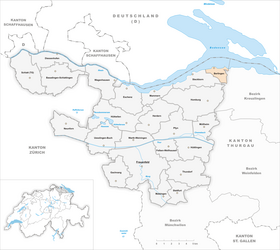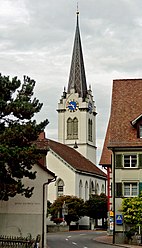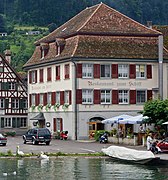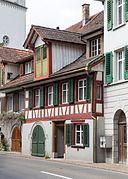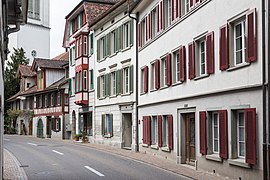Berlingen TG
| TG is the abbreviation for the canton of Thurgau in Switzerland and is used to avoid confusion with other entries of the name Berlingen . |
| Berlingen | |
|---|---|
| State : |
|
| Canton : |
|
| District : | Frauenfeld |
| BFS no. : | 4801 |
| Postal code : | 8267 |
| Coordinates : | 718 521 / 280 750 |
| Height : | 400 m above sea level M. |
| Height range : | 395–695 m above sea level M. |
| Area : | 3.58 km² |
| Residents: | 890 (December 31, 2018) |
| Population density : | 249 inhabitants per km² |
|
Proportion of foreigners : (residents without citizenship ) |
24.2% |
| Website: | www.berlingen.ch |
| Location of the municipality | |
Berlingen is a political municipality and a village in the canton of Thurgau in Switzerland and belongs to the Frauenfeld district . Until 2002 Berlingen was a unified community .
Geography and traffic
It is located on a brook delta on the south bank of the Untersee and is topographically limited by the slopes of the ridge of the lake . The lake level has an average height of 396 meters above sea level.
Beringen is accessed from the main road Schaffhausen – Kreuzlingen and has a train station on the Schaffhausen – Romanshorn railway line .
history

A previously suspected prehistoric bank settlement with pile dwellings was not confirmed by drilling in 1981. At the time of the Romans around 370 AD, according to unsecured reports , a watchtower is said to have been built over the White Rock, directly on the border with Steckborn . It was part of the line of defense that the Roman Emperor Valentinian I had built from Basel to Bregenz to secure the border against Germania .
In the year 894 (?) Berlingen was first mentioned in a document under the name Berenwanc - which means nothing more than Flur des Bero. In 1267 it was called the Bernanch , until the 18th century Bernang . In 1750 the village was named Berlingen.
In the Middle Ages , Berlingen belonged to the court and the parish of Steckborn . Landlord and collator was the Reichenau monastery . In 1504 Berlingen received its own court, which was subordinate to the Prince-Bishop of Constance from 1540 to 1798 and was administered by the Obervogtei Reichenau . The municipality of Berlingen, which was founded in 1803, was combined with the local municipality of Berlingen to form the unified municipality of Berlingen in 1870.
A benefice was donated in 1359 for the Michael's Chapel, which was occupied from 1332 . The Berlingen parish, founded in the 15th century, converted to the Reformation around 1524 and, with the help of Zurich , was able to assert itself against the monastery. The few Catholics have belonged to Steckborn ever since. According to legend, the Berling Altar in the monastery in Mittelzell comes from the chapel in Berlingen. It is said to have been thrown into the lake by the iconoclasts during the Reformation and salvaged as floating debris by the Reichenauers.
The basis of relative prosperity in the 19th century was viticulture, shipping and tannery . In the 20th century, the Naegeli jersey factory (1892–1983, 132 jobs in 1965) and the Neutal retirement home founded in 1910 (260 places and 250 employees in 1994) provided the majority of jobs in Berlingen.
coat of arms
Blazon : Two concentric yellow rings in blue .
The coat of arms from the Reichenau period has existed since the 18th century at the latest. Its meaning is unclear. The rings are interpreted as a symbol of the bond with the monastery and the blue ground for the lake.
population
 |
| year | 1850 | 1900 | 1950 | 1960 | 1980 | 1990 | 2000 | 2000 | 2010 | 2018 |
| Residents | 746 | 706 | 813 | 967 | 880 | 1036 | 854 | 854 | 847 | 893 |
Of the total of 893 inhabitants in the municipality of Berlingen in 2018, 216 or 24.2% were foreign nationals. 398 (44.6%) were Protestant Reformed and 208 (23.3%) were Roman Catholic.
economy
In 2016, Berlingen offered 246 jobs (converted to full-time positions). 2.2% of them worked in agriculture and forestry, 8.7% in industry, trade and construction and 89.1% in the service sector.
Attractions

The village of Berlingen is listed in the inventory of places worth protecting in Switzerland .
The Berling village church was built in 1842 on a brook delta, which forms a kind of peninsula. A St. Michael's Chapel has stood in the same place since the 13th century, and was replaced by a small church in 1659. When the latter became too small, it was decided to build the current church as one of the first neo-Gothic churches in Switzerland. At that time, this was a risk, as the churchgoers at the time were used to hall buildings. Napoleon III , who grew up in the nearby Arenenberg Castle , donated the pulpit and the marbled font for the church. In 1968 the church was renovated, restoring its original simplicity.
Personalities
- Hans Böhni (* 1937), university professor at the Institute for Building Materials, Materials and Corrosion at ETH Zurich from 1976 to 2002.
- Adolf Dietrich (1877–1957), “naive” painter. Lived and worked in Berlingen.
- Peter Dschulnigg (1943–2011), Catholic theologian. Last lived in Berlingen, died and buried here.
- Ulrich Guhl (1838–1924), Reformed theologian and politician. Was pastor in Berlingen from 1861 to 1865.
- Johann Konrad Kern (1808–1888), minister, statesman, diplomat, editor of the Federal Constitution of 1848. Was born in Berlingen, later worked from here.
- Marie Kunert (1871–1957), German politician. Died in Berlingen.
- Friedrich Schaltegger (1851–1936), later Thurgau canton archivist and librarian, was pastor in Berlingen from 1888–1901.
photos
literature
- Alfons Raimann, Peter Erni: The Art Monuments of the Canton of Thurgau, Volume VI. The Steckborn district. (= Kunstdenkmäler der Schweiz. Volume 98), edited by the Society for Swiss Art History GSK, Bern 2001, ISBN 3-906131-02-5 .
Web links
- Official website of the municipality of Berlingen
- Gregor Spuhler : Berlingen. In: Historical Lexicon of Switzerland .
Individual evidence
- ↑ Permanent and non-permanent resident population by year, canton, district, municipality, population type and gender (permanent resident population). In: bfs. admin.ch . Federal Statistical Office (FSO), August 31, 2019, accessed on December 22, 2019 .
- ↑ a b c Localities and their resident population. Edition 2019 . On the website of the Statistical Office of the Canton of Thurgau (Excel table; 0.1 MB), accessed on April 28, 2020.
- ↑ Numbers and facts. On the website of the municipality of Berlingen, accessed on March 28, 2020
- ↑ a b c municipal coat of arms . On the website of the State Archives of the Canton of Thurgau, accessed on December 8, 2019
- ↑ a b c d e story. On the website of the municipality of Berlingen, accessed on December 25, 2019
-
↑ a b c d e Gregor Spuhler : Berlingen. In: Historical Lexicon of Switzerland .
These sections are largely based on the entry in the Historical Lexicon of Switzerland (HLS), which, according to the HLS's usage information, is under the Creative Commons license - Attribution - Share under the same conditions 4.0 International (CC BY-SA 4.0). - ↑ StiASG , Urk. IV 407. Online at e-chartae , accessed on June 12, 2020.
- ↑ a b Population development of the municipalities. Canton Thurgau, 1850–2000 and resident population of the municipalities and change from the previous year. Canton of Thurgau, 1990–2018. On the website of the Statistical Office of the Canton of Thurgau (Excel tables; 0.1 MB each), accessed on April 28, 2020.
- ↑ Thurgau in figures 2019 . On the website of the Statistical Office of the Canton of Thurgau (PDF file; 1.8 MB), accessed on April 28, 2020.
- ↑ Information board at the Berlingen landing stage.
- ↑ Interesting facts about the history of the village church. ( Memento from December 22, 2015 in the Internet Archive ) On the website of the Protestant parish of Berlingen, accessed on October 18, 2012.


